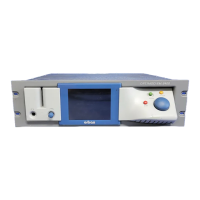3-54
OPERATION ORBAN Model 8400
tiband clipper/distortion controller), which can produce considerable audible
distortion if overdriven. The thresholds of the individual compressors have
been carefully tuned to prevent audible distortion with almost any program
material. Large changes in the frequency balance of the compressor outputs
will change this tuning, leaving the 8400 more vulnerable to unexpected au-
dible distortion with certain program material. Therefore, you should make
large changes in EQ with the bass and parametric equalizers and the HF en-
hancer, because these are located before the compressors. The compressors
will therefore protect the system from unusual overloads caused the chosen
equalization. Use the multiband mix controls only for fine-tuning.
You can also get a similar effect by adjusting the compression threshold of
the individual bands. This is comparably risky with reference to clipper
overload, but unlike the
MB Band Mix controls, does not affect the frequency
response when a given band is below threshold and is thus producing no
gain reduction.
Solo switches allow you to listen to any band (or any combination of bands) independ-
ently. This is a feature designed for intermediate or advanced users and developers when
they are creating new 8400 presets.
Please note that a single band will interact with the back-end clipping system quite differ-
ently than will that band when combined with all of the other bands. Therefore, don’t
assume that you can tune each band independently and have it sound the same when the
clipping system is processing all bands simultaneously.
Advanced Multiband and Band Mix Controls
The following Multiband and Band Mix controls are found only in the Advanced Modify
screen.
Compression Threshold
controls set the compression threshold in each band, in units of
dB below the final clipper threshold. We recommend making small changes around the
factory settings to avoid changing the range over which the
MB Clipping control operates.
These controls will affect the spectral balance of the processing above threshold, but are
also risky because they can strongly affect the amount of distortion produced by the
back-end clipping system.
B1-B4 Attack (Time)
controls set the speed with which the gain reduction in each band
responds to level changes at the input to a given band’s compressor. These controls,
which have never previously been available in an Orban processor, are risky and difficult
to adjust appropriately. They affect the sound of the processor in many subtle ways. The
main trade-off is “punch” (achieved with slower attack times) versus distortion and/or
pumping produced in the clipping system (because slower attack times increase over-
shoots that must be eliminated in the clipping system). The results are strongly program-
dependent, and must be verified with listening tests to a wide variety of program material.
The
Attack time controls are calibrated in arbitrary units. Higher numbers correspond to
slower attacks.

